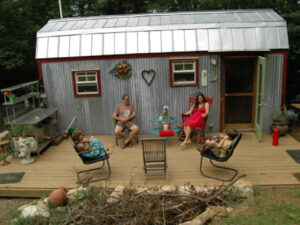Mobile tiny houses have become extremely popular in recent years as an innovative and environmentally friendly way to solve the problems of modern life. These little houses, often on wheels, are a great way to be environmentally conscious, exercise, and save money. This article discusses the growing interest in mobile tiny homes, their benefits, what to consider when designing them, and how they can change the way we live.
1. Advantages of Mobile Cabins:
- Cost-effectiveness: Mobile tiny homes are cheaper than regular homes, making homeownership more accessible to more people. These homes have a smaller footprint, lower construction costs, and often use do-it-yourself construction methods, providing affordable housing to a wide range of people.
- Mobility: One of the biggest advantages of mobile tiny homes is that they are easy to move. People can thus change their environment, discover new communities, and even adopt a nomadic lifestyle. People who value the experience of things and want a more active lifestyle will appreciate this flexibility.
- Durability: Many small mobile homes are manufactured with durability in mind. The houses try to minimize their impact on the environment by using environmentally friendly materials and energy-efficient systems. Because they are smaller than regular houses, they also use less energy and leave a smaller carbon footprint.
2. Design Considerations for Mobile Tiny Homes:
- Space optimization: When designing small homes, it is important to make the most of every square centimeter. Smart storage solutions, multi-use furniture, and open floor plans are all common ways to make a small space feel larger.
- Motion features: It is important to include features that keep the object stable while moving. Measures such as a solid foundation, secure storage of moving items, and a design that allows easy air circulation can improve the structural integrity of a mobile tiny home.
- Off-grid features: Many mobile tiny homes are equipped with features that work without electricity, such as solar panels, composting toilets, and rainwater harvesting systems. These eco-friendly technologies allow people to live without traditional utilities, making them feel more independent.
3. Impact on Lifestyle:
- Simplify life: Living in a small house with a minimalist concept encourages people to get rid of unnecessary things and make life easier. When people focus on what matters to them, staying away from materialism can make them happier and less stressed.
- Community involvement: Because tiny homes are portable, people can easily get closer to family, friends, or communities with shared interests. In a world where people often feel alone, this sense of connection is extremely helpful.
- Lower environmental impact: Mobile tiny homes are good for the environment in many ways. With smaller living spaces, people naturally use and throw less, which has a positive impact on the environment.
4. Existing Problems and Thoughts:
- Zoning laws and regulations: Legal issues can arise because local building and zoning laws may not be flexible enough to accommodate the unique features of a mobile tiny home. To make the regulatory environment more acceptable, people need to speak out and be better informed.
- Lack of space for the family: A small mobile home is suitable for one person or a couple, but families can run into problems due to the small space. Making a tiny house suitable for a family requires thinking outside the box and planning carefully.
- Infrastructure and utilities: Although off the grid, small mobile homes may have limited access to water, electricity, and a place to throw trash. To make these houses more useful in the wider environment, we need to come up with solutions and new infrastructure.
Conclusion
Mobile tiny homes have revolutionized the way we think about housing and living spaces. These tiny houses are a great alternative to traditional houses because they are affordable, easy to move, and environmentally friendly. As the movement grows, it is important to address the issue and push for policies that support it to gain mainstream acceptance and become part of our community. Moving to a tiny house is more than just a place to live; It is a lifestyle that challenges the status quo and promotes a more thoughtful and environmentally friendly lifestyle.
FAQs
1. What is a mobile tiny house?
A mobile tiny house is a small house that is usually built on wheels so that it can be easily moved. The homes are designed to make optimal use of space while being affordable and environmentally friendly.
2. What are the advantages of a portable tiny house?
Mobile tiny houses have many advantages, such as being affordable, easy to move, and environmentally friendly. They are cheap, allow you to get around, and often have eco-friendly features to reduce your impact on the environment.
3. What makes mobile tiny homes so affordable?
Because mobile tiny homes are smaller, cheaper to build, and generally easy to build yourself, they are affordable. The minimalist design philosophy also encourages people to live simpler, less materialistic lives, which can save money in the long run.
4. Can I move my tiny house on wheels?
Yes, one of the best things about mobile tiny homes is that they can be moved. They are built on wheels, allowing people to move and live in different places with ease, promoting a dynamic and adaptable lifestyle.
5. Are mobile tiny homes good for the environment?
Many mobile tiny homes are designed to be environmentally friendly. They often use environmentally friendly materials and energy-saving systems. Some can even operate without electricity, with solar panels and composting toilets, which help reduce environmental impact.
6. What are the most important things to consider when designing a mobile tiny house?
Some things to consider when designing small mobile homes are making the most of space, adding features that make them stable when moving, and ensuring they can operate off the grid so they can be self-sufficient. Clever ways to store items and furniture that can be used for multiple purposes are also common in small house designs.



